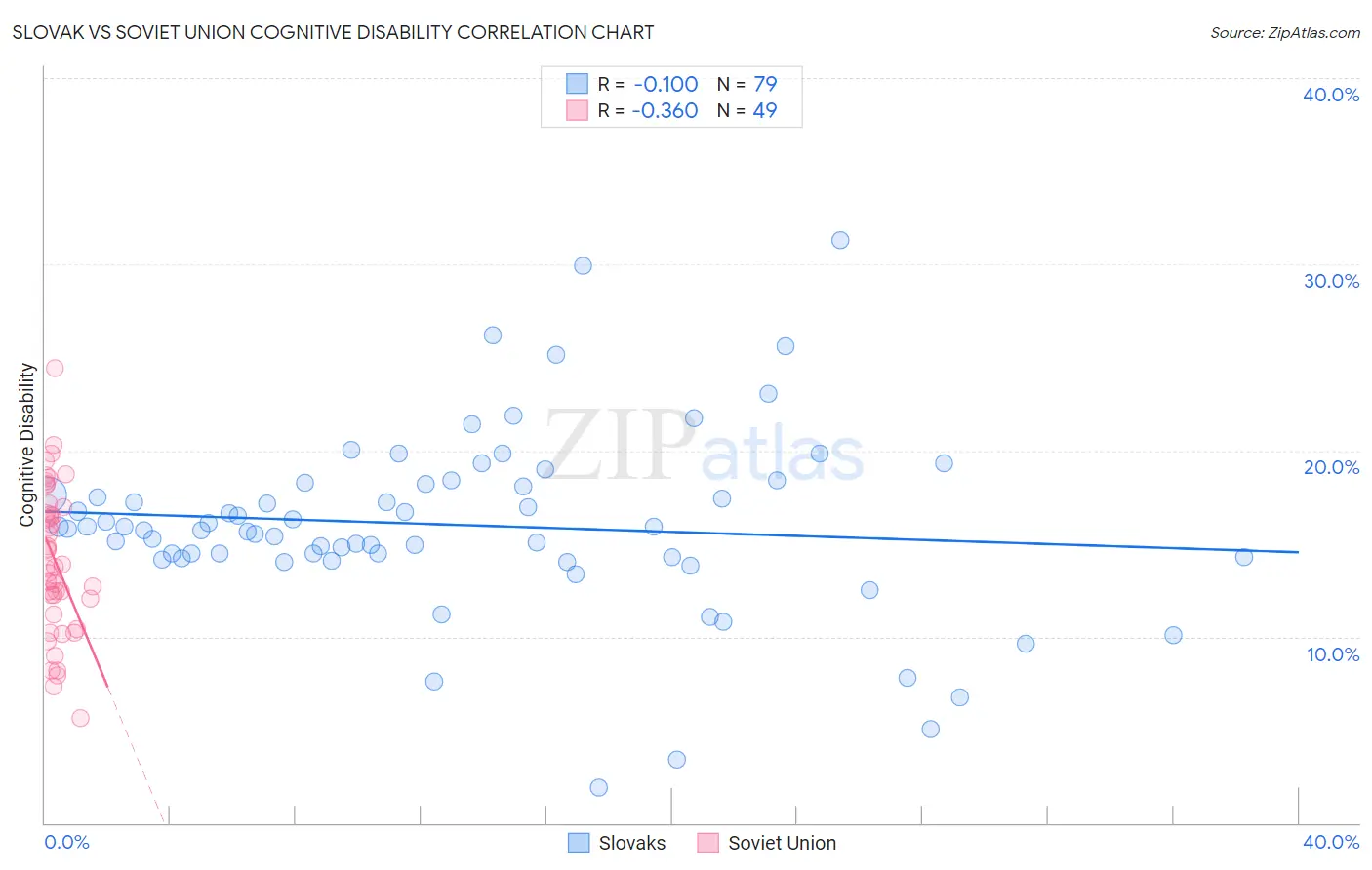Slovak vs Soviet Union Cognitive Disability
COMPARE
Slovak
Soviet Union
Cognitive Disability
Cognitive Disability Comparison
Slovaks
Soviet Union
16.4%
COGNITIVE DISABILITY
99.9/ 100
METRIC RATING
35th/ 347
METRIC RANK
16.5%
COGNITIVE DISABILITY
99.8/ 100
METRIC RATING
52nd/ 347
METRIC RANK
Slovak vs Soviet Union Cognitive Disability Correlation Chart
The statistical analysis conducted on geographies consisting of 397,859,059 people shows a slight negative correlation between the proportion of Slovaks and percentage of population with cognitive disability in the United States with a correlation coefficient (R) of -0.100 and weighted average of 16.4%. Similarly, the statistical analysis conducted on geographies consisting of 43,504,324 people shows a mild negative correlation between the proportion of Soviet Union and percentage of population with cognitive disability in the United States with a correlation coefficient (R) of -0.360 and weighted average of 16.5%, a difference of 0.55%.

Cognitive Disability Correlation Summary
| Measurement | Slovak | Soviet Union |
| Minimum | 1.9% | 5.6% |
| Maximum | 31.3% | 24.4% |
| Range | 29.4% | 18.8% |
| Mean | 16.0% | 14.1% |
| Median | 15.8% | 13.7% |
| Interquartile 25% (IQ1) | 14.2% | 11.6% |
| Interquartile 75% (IQ3) | 18.2% | 16.8% |
| Interquartile Range (IQR) | 3.9% | 5.2% |
| Standard Deviation (Sample) | 4.9% | 3.9% |
| Standard Deviation (Population) | 4.9% | 3.9% |
Demographics Similar to Slovaks and Soviet Union by Cognitive Disability
In terms of cognitive disability, the demographic groups most similar to Slovaks are Greek (16.4%, a difference of 0.010%), Italian (16.4%, a difference of 0.080%), Russian (16.4%, a difference of 0.080%), Slovene (16.5%, a difference of 0.15%), and Immigrants from Eastern Europe (16.5%, a difference of 0.17%). Similarly, the demographic groups most similar to Soviet Union are Immigrants from Korea (16.5%, a difference of 0.040%), Swedish (16.5%, a difference of 0.060%), Iranian (16.5%, a difference of 0.090%), Norwegian (16.5%, a difference of 0.090%), and Immigrants from Italy (16.5%, a difference of 0.13%).
| Demographics | Rating | Rank | Cognitive Disability |
| Italians | 99.9 /100 | #33 | Exceptional 16.4% |
| Russians | 99.9 /100 | #34 | Exceptional 16.4% |
| Slovaks | 99.9 /100 | #35 | Exceptional 16.4% |
| Greeks | 99.9 /100 | #36 | Exceptional 16.4% |
| Slovenes | 99.9 /100 | #37 | Exceptional 16.5% |
| Immigrants | Eastern Europe | 99.9 /100 | #38 | Exceptional 16.5% |
| Bolivians | 99.9 /100 | #39 | Exceptional 16.5% |
| Immigrants | Belarus | 99.9 /100 | #40 | Exceptional 16.5% |
| Cubans | 99.9 /100 | #41 | Exceptional 16.5% |
| Hungarians | 99.9 /100 | #42 | Exceptional 16.5% |
| Immigrants | Canada | 99.8 /100 | #43 | Exceptional 16.5% |
| Macedonians | 99.8 /100 | #44 | Exceptional 16.5% |
| Immigrants | Europe | 99.8 /100 | #45 | Exceptional 16.5% |
| Immigrants | Colombia | 99.8 /100 | #46 | Exceptional 16.5% |
| Immigrants | Italy | 99.8 /100 | #47 | Exceptional 16.5% |
| Immigrants | North America | 99.8 /100 | #48 | Exceptional 16.5% |
| Iranians | 99.8 /100 | #49 | Exceptional 16.5% |
| Norwegians | 99.8 /100 | #50 | Exceptional 16.5% |
| Immigrants | Korea | 99.8 /100 | #51 | Exceptional 16.5% |
| Soviet Union | 99.8 /100 | #52 | Exceptional 16.5% |
| Swedes | 99.8 /100 | #53 | Exceptional 16.5% |